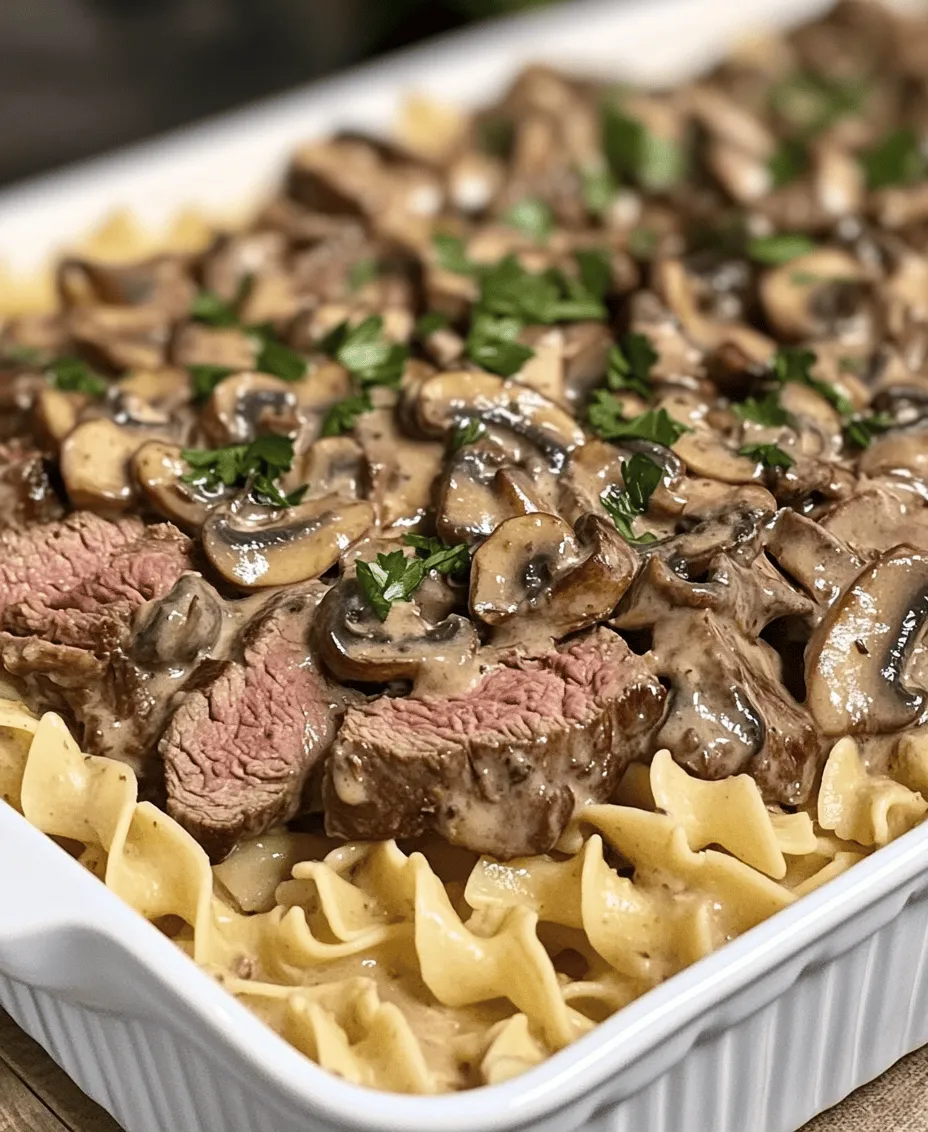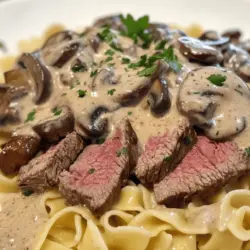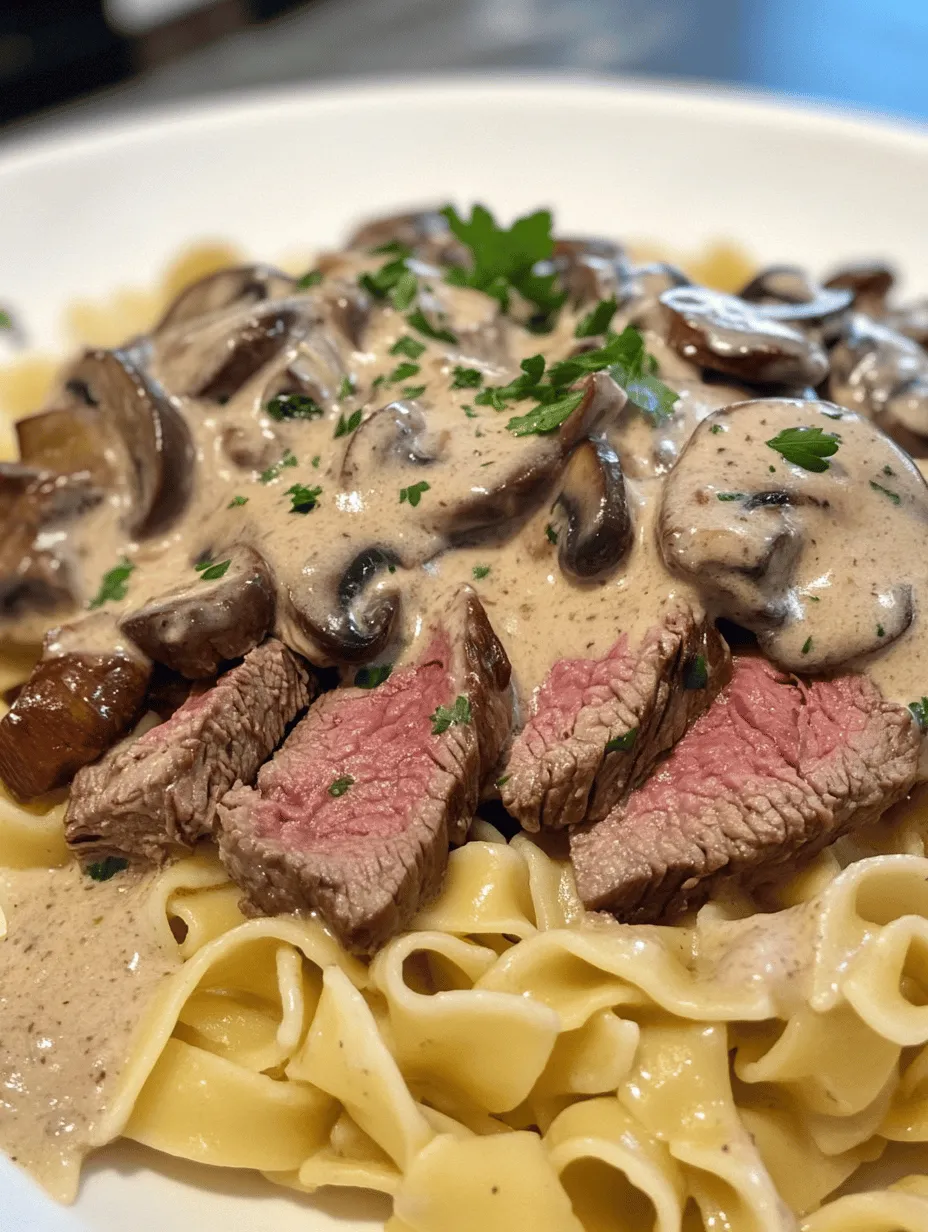Introduction
Beef Stroganoff is a classic dish that has delighted palates around the world with its rich flavors and comforting qualities. Originating from Russia in the 19th century, this hearty meal combines tender beef, creamy sauce, and often mushrooms, creating a symphony of taste that transcends cultural boundaries. This dish has evolved over the years, becoming a staple in many households, particularly in the United States, where it is cherished as a quintessential comfort food.
Comfort food plays a vital role in culinary traditions, bringing warmth and nostalgia to the dining table. Whether it’s a rainy day or a family gathering, meals like Beef Stroganoff evoke feelings of coziness and satisfaction. This particular recipe focuses on a savory, creamy Beef Stroganoff served over egg noodles, making it not only delicious but also filling and satisfying for all ages.
In this article, we’ll explore the delightful journey of preparing Savory Creamy Beef Stroganoff with Egg Noodles. You’ll learn about its historical background, the nutritional benefits of the ingredients, and the detailed steps to create this sumptuous dish in your own kitchen.
Understanding Beef Stroganoff
Historical Context of Beef Stroganoff
The origins of Beef Stroganoff can be traced back to mid-19th century Russia, attributed to the Stroganov family, who were wealthy merchants and landowners. The dish was likely created by chefs who sought to impress their affluent patrons with a meal that showcased the finest ingredients available. The original recipe featured sautéed pieces of beef served in a creamy sauce, often accompanied by a side of rice or mashed potatoes.
As the dish gained popularity, it began to make its way across Europe and into the United States, where it adapted to local tastes and ingredient availability. Today, you can find countless variations of Beef Stroganoff, each with its own unique twist, reflecting the cultural influences of its region.
Variations of the Dish Across Different Cultures
While the traditional Beef Stroganoff remains popular, many cultures have embraced and adapted the dish to suit their culinary preferences. In Hungary, for example, paprika is often added to deepen the flavor profile, while in Germany, you might find the dish served with spätzle instead of egg noodles.
Even within the United States, variations abound, ranging from the use of cream of mushroom soup to shortcut versions that simplify preparation. Vegetarian and vegan adaptations have also emerged, showcasing mushrooms or plant-based proteins in lieu of beef. Each variation maintains the essence of the original while offering a unique taste that reflects local traditions and available ingredients.
Nutritional Benefits of the Ingredients Used
Beyond its delightful taste, Beef Stroganoff boasts several nutritional benefits. The primary ingredient, beef sirloin, is a great source of high-quality protein, essential for muscle growth and repair. It’s also rich in important vitamins and minerals, including iron, zinc, and B vitamins, which support energy metabolism and immune function.
Mushrooms, another key component, are low in calories but high in nutrients. They provide antioxidants and are a good source of fiber, which aids in digestion. The addition of aromatics like onions and garlic not only enhances flavor but also contributes health benefits, including anti-inflammatory properties and improved heart health.
Sour cream, while rich and creamy, offers calcium and vitamin B12, supporting bone health and energy levels. By incorporating egg noodles, you gain carbohydrates that serve as a primary energy source, making this dish a well-rounded meal option when enjoyed in moderation.
Ingredients Breakdown
Creating a mouth-watering Beef Stroganoff begins with selecting the right ingredients. Here’s a detailed look at each component of this savory dish:
Beef Sirloin
Choosing the right cut of beef is crucial for achieving a tender and flavorful Stroganoff. Beef sirloin is an excellent choice due to its balance of tenderness and flavor. When selecting sirloin, look for cuts that have a bright red color and a moderate amount of marbling, which contributes to juiciness.
Cooking properties of sirloin allow it to sear beautifully, creating a crust that locks in moisture and flavor. This cut cooks quickly, making it perfect for a dish that requires a brief sauté, ensuring the beef remains tender and not overcooked.
Olive Oil
Olive oil is not just a cooking fat; it’s a flavor enhancer packed with health benefits. Rich in monounsaturated fats, olive oil supports heart health and provides antioxidants that can combat inflammation. Using olive oil in your Stroganoff helps to sauté the beef and aromatics, imparting a subtle flavor that complements the dish beautifully.
Aromatics: The Role of Onion and Garlic
Onion and garlic are essential aromatics that form the flavor backbone of many savory dishes, including Beef Stroganoff. Onions provide sweetness and depth, while garlic adds a pungent kick that elevates the overall taste. Sautéing these ingredients until they are soft and fragrant releases their natural sugars and flavors, creating a solid foundation for the creamy sauce.
Mushrooms
Mushrooms are a signature ingredient in Beef Stroganoff, adding earthiness and a meaty texture. Varieties such as cremini, button, or shiitake work well in this dish. Each type brings its unique flavor profile; for instance, shiitake mushrooms offer a rich, umami taste. When preparing your Stroganoff, ensure that the mushrooms are sliced evenly for uniform cooking and maximum flavor extraction.
Beef Broth
The depth of flavor in your Stroganoff is significantly influenced by the quality of the beef broth used. A rich, homemade broth is ideal, as it provides a robust base for the sauce. If using store-bought broth, opt for low-sodium options to control the saltiness of your dish. A good broth enhances the overall taste, creating a comforting and savory sauce that perfectly coats the beef and noodles.
Worcestershire Sauce
Worcestershire sauce is a classic ingredient in many savory recipes, and it plays a pivotal role in Beef Stroganoff. This condiment adds a complex umami flavor, enhancing the richness of the sauce. A few dashes will elevate the dish, providing a savory depth that balances the creaminess of the sour cream and the sweetness of the onions.
Sour Cream
Sour cream is the star ingredient that lends creaminess and tang to Beef Stroganoff. It not only enriches the sauce but also balances the flavors, preventing the dish from becoming overly rich. Look for full-fat sour cream for the best texture and flavor, as it will create a velvety sauce that clings beautifully to the beef and noodles.
Dijon Mustard and Paprika
Adding Dijon mustard and paprika brings complexity to the dish. Dijon mustard adds a subtle tanginess that brightens the flavors, while paprika contributes warmth and color. Together, they enhance the overall taste profile and make the Stroganoff more inviting and delicious.
Egg Noodles
Egg noodles are the traditional choice for serving with Beef Stroganoff. Their broad, flat shape allows them to hold onto the creamy sauce, ensuring each bite is flavorful. When selecting egg noodles, look for those made with high-quality ingredients, and be sure to check the cooking instructions to achieve the perfect texture.
Garnish with Parsley
Fresh parsley is often used as a garnish, providing a pop of color and a fresh herbaceous flavor that balances the richness of the dish. Sprinkle chopped parsley over the finished Stroganoff for an appealing presentation and an added layer of taste.
Preparation Steps Explained
Now that we have covered the ingredients, it’s time to delve into the preparation steps for making Savory Creamy Beef Stroganoff with Egg Noodles. The first step in this culinary journey is cooking the egg noodles to ensure they are perfectly al dente.
Cooking the Egg Noodles
To start, fill a large pot with water and bring it to a rolling boil. Adding salt to the water is essential; this not only flavors the noodles but also enhances their overall taste. A general rule of thumb is to use about 1 tablespoon of salt for every 4 quarts of water.
Once the water is boiling, add the egg noodles and stir gently to prevent them from sticking together. Cooking them according to the package instructions is crucial; typically, egg noodles require around 7 to 9 minutes. For the ideal al dente texture, taste a noodle a minute or two before the suggested cooking time. The goal is to achieve a firm yet tender noodle that holds its shape in the creamy sauce.
After the noodles are cooked to your liking, drain them in a colander and set them aside. It’s important not to rinse the noodles, as this will wash away the starch that helps the sauce cling to them. With the egg noodles prepared and waiting, you’re now ready to move on to the next stage of creating your delicious Beef Stroganoff.
Stay tuned as we continue to explore the cooking process, guiding you step-by-step through this savory dish that’s sure to become a family favorite.

Searing the Beef
To achieve the perfect Savory Creamy Beef Stroganoff, the first step in the cooking process involves searing the beef. This technique not only enhances the meat’s flavor but also contributes to the overall richness of the dish.
Techniques for Browning Meat Properly
Begin by slicing your beef into thin strips, approximately 1/4 inch thick. This thickness is crucial for quick cooking and tender results. Make sure to pat the beef dry with paper towels before seasoning it with salt and pepper. A dry surface is essential for achieving a good sear, as moisture can inhibit browning.
Heat a heavy-bottomed skillet or a cast-iron pan over medium-high heat, adding a tablespoon of oil with a high smoke point, like canola or grapeseed oil. Once the oil shimmers, carefully add the beef strips in a single layer, ensuring not to overcrowd the pan. Overcrowding can lead to steaming rather than searing, which will prevent that beautiful brown crust from forming.
Importance of Doing This in Batches for Even Cooking
If you have a large quantity of beef, consider cooking it in batches. This method ensures each piece gets enough contact with the hot surface of the pan, allowing for even browning and optimal flavor development. After a couple of minutes, once the beef is browned on one side, use tongs to flip the pieces and brown the other side. Transfer the seared beef to a plate and cover it with foil to keep warm while you prepare the other ingredients.
Sautéing the Vegetables
Once the beef is seared and resting, it’s time to sauté the vegetables, which will add depth and flavor to your dish.
Timing for Adding Ingredients for Optimal Flavor Extraction
In the same skillet, add a little more oil if necessary and introduce your chopped onions. Sauté them for about 2-3 minutes until they become translucent. Next, add minced garlic; this step is crucial because garlic can burn easily. Cook for an additional minute until fragrant, then add the sliced mushrooms, which are a staple in traditional Beef Stroganoff.
Tips on Avoiding Soggy Mushrooms
To ensure your mushrooms are perfectly cooked and not soggy, avoid overcrowding the skillet. Just like with the beef, give the mushrooms space in the pan. If you have too many to fit comfortably, sauté them in batches. Cook the mushrooms until they are golden brown and the moisture has evaporated, which typically takes 5-7 minutes. This process enhances their flavor and texture, making them a delightful addition to the dish.
Combining Ingredients
Now that your beef and vegetables are ready, it’s time to combine them into a harmonious mixture.
Importance of Deglazing the Pan for Flavor
Return the seared beef to the skillet with the sautéed vegetables. Here’s where the magic happens: pour in a splash of beef broth and use a wooden spoon to scrape up any browned bits stuck to the bottom of the pan. This is known as deglazing and is crucial for incorporating all the flavorful residues into your sauce.
Simmering Versus Boiling: Understanding the Cooking Process
After deglazing, add the remaining beef broth along with Worcestershire sauce and Dijon mustard. Bring the mixture to a gentle simmer. It’s important to avoid a rolling boil, as this can toughen the meat. Let it simmer on low heat for about 10-15 minutes until the beef is cooked through and the flavors meld together beautifully.
Making it Creamy
The final step in creating your creamy sauce involves incorporating the sour cream.
Tips for Preventing Curdling of Sour Cream
To prevent curdling, it’s essential to temper the sour cream. Remove a ladleful of the hot broth from the skillet and mix it with the sour cream in a separate bowl. This process gradually raises the temperature of the sour cream, preventing it from curdling once added to the hot skillet. Stir the tempered sour cream mixture back into the skillet, combining it well with the beef and vegetables.
Balancing Flavors with Salt and Pepper
Taste the sauce and adjust the seasoning as necessary. A sprinkle of salt and freshly cracked black pepper can elevate the dish, bringing all the flavors together. Remember, the seasoning can be adjusted based on your palate and preference.
Final Assembly and Serving Suggestions
With the creamy beef stroganoff sauce ready, it’s time to toss it with the egg noodles.
Tossing Noodles with the Beef Mixture
Cook the egg noodles according to the package instructions until al dente. Drain them and add directly to the skillet with the beef stroganoff sauce. Use tongs or a large spoon to gently toss the noodles, ensuring they are evenly coated with the sauce. This step is vital to ensure every bite is rich and flavorful.
Presentation Ideas: Plating Tips for an Appealing Dish
To serve, consider using wide, shallow bowls to showcase the creamy beef stroganoff beautifully. Garnish with freshly chopped parsley or chives for a pop of color and added freshness. A sprinkle of paprika can also lend a lovely contrast.
Suggestions for Side Dishes or Accompaniments
Beef stroganoff pairs wonderfully with a variety of side dishes. Consider serving it with a crisp green salad dressed in a light vinaigrette to balance the richness of the dish. Alternatively, steamed broccoli or green beans can add a nice crunch and color to your meal. For those who enjoy bread, a slice of crusty baguette or buttered dinner rolls is perfect for soaking up the creamy sauce.
Nutritional Information
Understanding the nutritional content of your homemade Beef Stroganoff can help you make informed choices.
Breakdown of Calories, Fats, Proteins, and Carbohydrates Per Serving
On average, a serving of beef stroganoff with egg noodles contains approximately:
– Calories: 520
– Total Fat: 22g
– Saturated Fat: 10g
– Protein: 30g
– Carbohydrates: 50g
– Fiber: 2g
– Sugars: 3g
These values can vary based on the specific ingredients used and portion sizes.
Discussion on Dietary Modifications
If you’re looking to lighten the dish, consider using low-fat sour cream or Greek yogurt as a substitute for the sour cream to reduce calories and fats. For a gluten-free option, substitute traditional egg noodles with gluten-free pasta or spiralized vegetables like zucchini or squash. This allows you to enjoy the rich flavors of Beef Stroganoff while accommodating various dietary preferences.
Conclusion
Making homemade Beef Stroganoff is not just about following a recipe; it’s about creating a comforting meal that brings joy to the table. The combination of tender beef, sautéed mushrooms, and creamy sauce served over egg noodles is a classic dish that never goes out of style.
Embrace the opportunity to experiment with this recipe. Consider adding your favorite vegetables, such as bell peppers or peas, for added nutrition and flavor. You can also play with different types of meat, such as chicken or even mushrooms for a vegetarian version.
In family meals and gatherings, Beef Stroganoff holds a cherished place, evoking warmth and satisfaction. So, gather your loved ones, serve this delightful dish, and enjoy the comforting embrace of a homemade meal.



